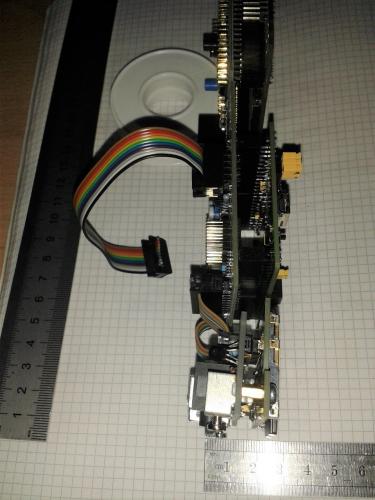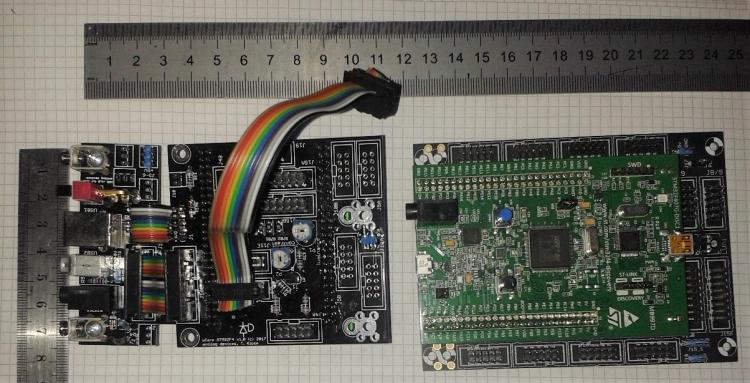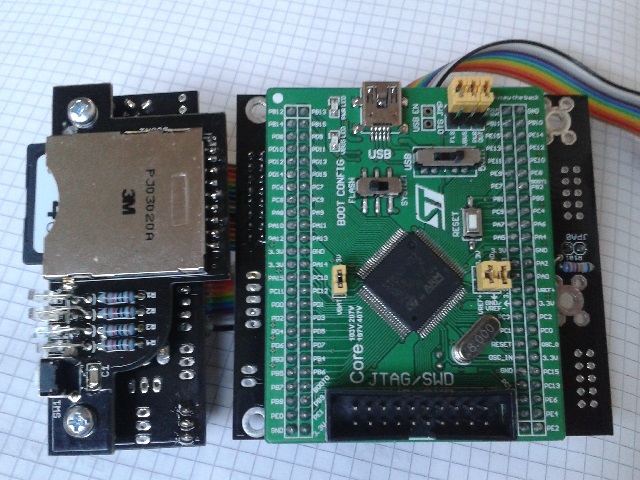-
Posts
2,524 -
Joined
-
Last visited
-
Days Won
149
Content Type
Profiles
Forums
Blogs
Gallery
Everything posted by latigid on
-
Just replicate this functionality: No website for the moment. I'll decide in the next short while how to proceed. Best, Andy
-
PA0, or you can buy a Core from me, there you get the pins on a separate header :)
-
Hallo Gerd, Gerne! Vielleicht TK. kann das Schema hochladen. Viele Gruesse, Andy
-
Hallo Gerd, Diese Pins haben kein elektronische Funktion. Die Jumpers koennen zu bleiben, oder du kannst die abmontieren. Siehst das Schema Seite 27 , JP2 und JP3 an. Gruss, Andy
-

MIOS32 Reset to Allow ST Link Flash Access
latigid on replied to hyperr's topic in MIDIbox Tools & MIOS Studio
The flashing LD1 has occurred ever since the newer STLink firmware. It's basically saying "there's power but no USB connection" and can be safely ignored. In the "faulty" FW this also held the main F4 MCU in reset. -
Thanks Tim, and best of luck.
-
Bruno, looks nice! Your offer is kind, but I think it will be okay with what I have. In my experience, builders have quite some trouble even with SOIC parts, so I try to go no smaller than SOIC/1206/SOT-23. And of course THT parts when possible as they make nice jumpers! I think the Waveshare paradigm is a good one to follow as they do a lot of STM chips: http://www.waveshare.com/product/mcu-tools/stm32/core/core429i.htm F4 I (with much more IO) and 1MB SD RAM onboard http://www.waveshare.com/product/mcu-tools/stm32/core/core746i.htm F7 Core etc. Yannick, I need some weeks at least to talk with the Bavarians. I also have to prioritise giving boards out to those interested in the SEQ. But hopefully more becomes clear soon. Best, Andy
-
Hello, total height seems to be about 30-35mm: So even a bit higher than the Disco version with the bottom headers; about the same without. There's not much reason to keep the panel board close to the Core, although I will do it like that for the SEQ and everything aligns nicely. I suppose the signal integrity (USB, SD) is better with shorter cables. The panel connectors are themselves quite high. Honestly, I think the only way to do it shorter height-wise would be with a dedicated STM32F4 chip on a custom PCB. With a breakout it's fairly much plug-and-play, and probably cheaper. https://eckstein-shop.de/Core407V
-
Here's a new STM32F4 Core: It has most of the functionality of the Discovery one, but has a few improvements: USB ports are on the breakout, so there's proper USB B USB A "host" - still need to test this, but it's normally done setting the ID pin low. I've put a panel switch for selecting host/slave and there's a jumper to power the slaved device if needed. LEDs and reset button on the panel; "blue button" as a jumper a 3.5mm socket for a footswitch or gate (or for other purposes) some connectors for +5V supply direct off the USB bus 3v3 Vreg is rated at 1000mA I think the panel connectors could be distant from the Core I haven't tested the AINs, but it is possible to use an external reference. At the moment I have the breakout mounted on female headers; I suppose they could be directly soldered if extra height is needed. The JTAG and other pin headers do take up a bit of vertical height. These could be cut off if needed; the breakout pins are still there on the headers. There is a realtime clock oscillator (and caps) that I removed as they overlapped with a port. A downside compared to Discovery is that there isn't any ST-Link. This is easily overcome with a cheap ST-link clone, or even an old Discovery board could be used. At least all of the functions for a SEQ are working well. I realise that some of the cabling etc. is a bit wonky for the moment. Best, Andy
-
This is all I know: https://www.muffwiggler.com/forum/viewtopic.php?p=2542218#2542218
-
I think what has happened is the newer batch is set up to use a different clock frequency. Hopefully that's all.
-
Just had a nice jam using the BLM. How are we going with shifting views on on the y axis? It's okay to view just 16 notes, but I find it restricts the usage, especially when using a "polyphonic" track. Perhaps an additional idea: currently the encoder moves just one note up or down when a polyphonic track is enabled. Could the step encoder instead shift the whole shape by semitones? (This may be the Weizen talking.)
-
-
Did you define the max number of LCDs? I have some PCBs that provide more CS lines on simple headers if you need.
-
Here's one based on big beat with a lot of analogue Rhodes Chroma pads and FX, distorted Voyager + Sherman Filterbank. Dark at the beginning but quite uplifting later on. :).
-
I think "Nth" is what you want, but check the wiki.
-
Yep, you're right, I got my wires crossed. The 3v vreg (+ diodes) will likely have trouble if the ambient temperature is high.
-
Enforce bootloader mode with the blue button held during startup, open MIOS Studio and set the LCD option and store.
-
Right, but as a test, why not try booting NG to see if it's something weird with KB or customisation? Or are these rare problems with Mac MIDI drivers?
-
Lots of data being sent? How about if you load the default NG program with no customisation?
-
Oscillators are not inherently unstable, but our hearing means we perceive pitch exponentially. So from one octave to the next means a doubling in frequency. If you want to control pitch on a VCO linearly (commonly 1 volt per octave), then you need an exponential converter for your keyboard or MIDI data. Most of these circuits have a temperature coefficient that is always present. Digital oscillators just count a number of divisions of the master clock. Quartz resonates at a very specific frequency, and so it's much easier to count pulses this way. I think the SID uses a lookup table to derive the oscillator frequency.
-
Here's a long one A bit of drum'n'bass and goes into some more ambient house stuff. The bass on the Rhodes is a bit "flabby" but there you go.
-
IIRC the CPU monitor is in the SEQ itself through one of the menus.
-
If using the STM32F4 Core, you can remove the jumper for USB power and just plug into the 0.1" header. The 80% CPU usage seems high. I still wonder about the 3V supply.






